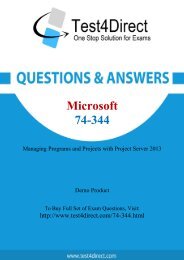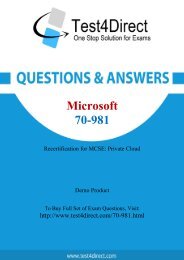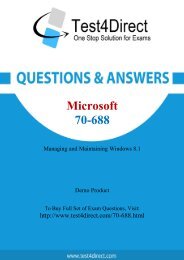You also want an ePaper? Increase the reach of your titles
YUMPU automatically turns print PDFs into web optimized ePapers that Google loves.
Microsoft<br />
<strong>70</strong>-<strong>516CSHARP</strong><br />
Accessing Data with Microsoft .NET Framework<br />
Demo Product<br />
To Buy Full Set of Exam Questions, Visit:<br />
http://www.test4direct.com/<strong>70</strong>-<strong>516CSHARP</strong>.html
Question: 1<br />
You use Microsoft Visual Studio 2010 and Microsoft .NET Framework 4 to create an application. The<br />
application contains the following code segment. (Line numbers are included for reference only.)<br />
01 class DataAccessLayer<br />
02 {<br />
03 private static string connString;<br />
04<br />
05 ...<br />
06 public static DataTable GetDataTable(string command){<br />
07<br />
08 ...<br />
09 }<br />
10 }<br />
You need to define the connection life cycle of the DataAccessLayer class. You also need to ensure<br />
that the application uses the minimum number of connections to the database. What should you do?<br />
Insert the following code segment at line 04.<br />
private static SqlConnection conn = new SqlConnection(connString);<br />
public static void Open(){<br />
conn.Open();<br />
}<br />
public static void Close(){<br />
conn.Close();<br />
}<br />
B.Insert the following code segment at line 04.<br />
private SqlConnection conn = new SqlConnection(connString);<br />
public void Open(){<br />
conn.Open(); }<br />
public void Close(){<br />
conn.Close();<br />
}<br />
C.Replace line 01 with the following code segment.<br />
class DataAccessLayer : IDisposable<br />
Insert the following code segment to line 04.<br />
private SqlConnection conn = new SqlConnection(connString);<br />
public void Open(){<br />
conn.Open();<br />
}<br />
public void Dispose(){<br />
conn.Close();<br />
}<br />
D.Insert the following code segment at line 07.<br />
using (SqlConnection conn = new SqlConnection(connString)){<br />
conn.Open();<br />
}<br />
Answer: D
Explanation:<br />
One thing you should always do is to make sure your connections are always opened within a using<br />
statement.<br />
Using statements will ensure that even if your application raises an exception while the connection is<br />
open, it will always be closed<br />
(returned to the pool) before your request is complete. This is very important, otherwise there could<br />
be connection leaks.<br />
Question: 2<br />
You use Microsoft Visual Studio 2010 and Microsoft .NET Framework 4 to create a Windows<br />
Communication Foundation (WCF) Data Services service. You discover that when an application<br />
submits a PUT or DELETE request to the Data Services service, it receives an error. You need to ensure<br />
that the application can access the service. Which header and request type should you use in the<br />
application?<br />
A. an X-HTTP-Method header as part of a POST request<br />
B. an X-HTTP-Method header as part of a GET request<br />
C. an HTTP ContentType header as part of a POST request<br />
D. an HTTP ContentType header as part of a GET request<br />
Question: 3<br />
Answer: A<br />
Explanation:<br />
The X-HTTP-Method header can be added to a POST request that signals that the server MUST<br />
process the request not as a POST, but as if the HTTP verb specified as the value of the header was<br />
used as the method on the HTTP request's request line, as specified in [RFC2616] section 5.1. This<br />
technique is often referred to as "verb tunneling". This header is only valid when on HTTP POST<br />
requests.<br />
X-HTTPMethod<br />
(http://msdn.microsoft.com/en-us/library/dd541471(v=prot.10).aspx)<br />
You use Microsoft Visual Studio 2010 and Microsoft .NET Framework 4 to create a Windows<br />
Communication Foundation (WCF) Data Services service. The service connects to a Microsoft SQL<br />
Server 2008 database. The service is hosted by an Internet Information Services (IIS) 6.0 Web server.<br />
The application works correctly in the development environment. However, when you connect to the<br />
service on the production server, attempting to update or delete an entity results in an error. You<br />
need to ensure that you can update and delete entities on the production server. What should you<br />
do?<br />
A. Add the following line of code to the InitializeService method of the service.<br />
config.SetEntitySetAccessRule ("*",EntitySetRights.WriteDelete |<br />
EntitySetRights.WriteInsert);<br />
B. Add the following line of code to the InitializeService method of the service.<br />
config.SetEntitySetAccessRule ("*",EntitySetRights.WriteDelete |<br />
EntitySetRights.WriteMerge);<br />
C. Configure IIS to allow the PUT and DELETE verbs for the .svc Application Extension.<br />
D. Configure IIS to allow the POST and DELETE verbs for the .svc Application Extension.
Question: 4<br />
Answer: C<br />
Explanation:<br />
An OData client accesses data provided by an OData service using standard HTTP. The OData protocol<br />
largely follows the conventions defined by REST, which define how HTTP verbs are used. The most<br />
important of these verbs are:<br />
GET: Reads data from one or more entities.<br />
PUT: Updates an existing entity, replacing all of its properties.<br />
MERGE: Updates an existing entity, but replaces only specified properties[2].<br />
POST: Creates a new entity.<br />
DELETE: Removes an entity.<br />
Http Header Verbs Enumeration<br />
(http://msdn.microsoft.com/en-us/library/windows/desktop/aa364664(v=vs.85).aspx )<br />
WCF Data Services Overview<br />
(http://msdn.microsoft.com/en-us/library/cc668794.aspx)<br />
Introduction to OData Protocol<br />
(http://msdn.microsoft.com/en-us/data/hh237663)<br />
You use Microsoft .NET Framework 4 to develop an application that connects to a Microsoft SQL<br />
Server 2008 database by using SQL Server authentication. The application contains the following<br />
connection string. SERVER=DBSERVER-01; DATABASE=pubs; uid=sa; pwd=secret; You need to ensure<br />
that the password value in the connection string property of a SqlConnection object does not exist<br />
after the Open method is called. What should you add to the connection string?<br />
A. Persist Security Info=True<br />
B. Trusted_Connection=True<br />
C. Persist Security Info=False<br />
D. Trusted_Connection=False<br />
Question: 5<br />
Answer: C<br />
Explanation:<br />
The Persist Security Info property specifies whether the data source can persist sensitive<br />
authentication information such as a password.<br />
Persist Security Info Property<br />
(http://msdn.microsoft.com/en-us/library/aa214039(v=sql.80).aspx)<br />
You use Microsoft Visual Studio 2010 and Microsoft .NET Framework 4 to create an application. The<br />
application connects to a Microsoft SQL Server database. The application uses the ADO.NET Entity<br />
Framework to manage order data. The application makes a Web service call to obtain orders from an<br />
order-tracking system. You need to ensure that the orders are added to the local data store. Which<br />
method should you call on the ObjectContext?<br />
A. Attach<br />
B. AttachTo
C. AddObject<br />
D. ApplyCurrentValues<br />
Question: 6<br />
Answer: C<br />
Explanation:<br />
ObjectContext.AddObject() Call AddObject on the ObjectContext to add the object to the object<br />
context.<br />
Do this when the object is a new object that does not yet exist in the data source.<br />
ObjectContext.Attach() Call Attach on the ObjectContext to attach the object to the object context.<br />
Do this when the object already exists in the data source but is currently not attached to the context.<br />
If the object being attached has related objects, those objects will also be attached to the object<br />
context.<br />
Objects are added to the object context in an unchanged state.<br />
The object that is passed to the Attach method must have a valid EntityKey value.<br />
If the object does not have a valid EntityKey value, use the AttachTo method to specify the name of<br />
the entity set.<br />
ObjectContext.AttachTo() Call AttachTo on the ObjectContext to attach the object to a specific entity<br />
set in the object context or if the object has a null (Nothing in Visual Basic) EntityKey value.<br />
The object being attached is not required to have an EntityKey associated with it. If the object does<br />
not have an entity key, then entitySetName cannot be an empty string.<br />
ApplyCurrentValues() method is used to apply changes that were made to objects outside<br />
the ObjectContext, such as detached objects that are received by a Web service.<br />
The method copies the scalar values from the supplied object into the object in the ObjectContext<br />
that has the same key.<br />
You can use the EntityKey of the detached object to retrieve an instance of this object from the data<br />
source.<br />
You use Microsoft Visual Studio 2010 and Microsoft .NET Framework 4 to create an application. The<br />
application connects to a Microsoft SQL Server database. The application uses the ADO.NET Entity<br />
Framework to model entities. The database includes objects based on the exhibit. (Click the Exhibit<br />
button.)
The application includes the following code segment. (Line numbers are included for reference only.)<br />
01 using (AdventureWorksEntities advWorksContext = new AdventureWorksEntities()){<br />
02<br />
03 }<br />
You need to retrieve a list of all Products from todays sales orders for a specified customer. You also<br />
need to ensure that the application uses the minimum amount of memory when retrieving the list.<br />
Which code segment should you insert at line 02?<br />
A. Contact customer = context.Contact.Where("it.ContactID =<br />
@customerId", new ObjectParameter("customerId", customerId)).First();<br />
customer.SalesOrderHeader.Load();<br />
foreach (SalesOrderHeader order in customer.SalesOrderHeader)<br />
{<br />
order.SalesOrderDetail.Load();<br />
if (order.OrderDate.Date == DateTime.Today.Date)<br />
{<br />
foreach (SalesOrderDetail item in order.SalesOrderDetail)<br />
{<br />
Console.WriteLine(String.Format("Product: {0} ", item.ProductID));<br />
}<br />
}<br />
}<br />
B.Contact customer = context.Contact.Where("it.ContactID =<br />
@customerId", new ObjectParameter("customerId", customerId)).First();<br />
customer.SalesOrderHeader.Load();<br />
foreach (SalesOrderHeader order in customer.SalesOrderHeader){<br />
if (order.OrderDate.Date == DateTime.Today.Date)<br />
{<br />
order.SalesOrderDetail.Load();<br />
foreach (SalesOrderDetail item in order.SalesOrderDetail)<br />
{<br />
Console.WriteLine(String.Format("Product: {0} ", item.ProductID));<br />
}<br />
}<br />
}<br />
C.Contact customer = (from contact in context.Contact.Include("SalesOrderHeader")<br />
select contact).FirstOrDefault();<br />
foreach (SalesOrderHeader order in customer.SalesOrderHeader)<br />
{<br />
order.SalesOrderDetail.Load();<br />
if (order.OrderDate.Date == DateTime.Today.Date){<br />
foreach (SalesOrderDetail item in order.SalesOrderDetail)<br />
{<br />
Console.WriteLine(String.Format("Product: {0} ", item.ProductID));<br />
}<br />
}<br />
}<br />
D.Contact customer = (from contact in context.Contact.Include("SalesOrderHeader.SalesOrderDetail")<br />
select contact).FirstOrDefault();<br />
foreach (SalesOrderHeader order in customer.SalesOrderHeader)<br />
{
if (order.OrderDate.Date == DateTime.Today.Date)<br />
{<br />
foreach (SalesOrderDetail item in order.SalesOrderDetail)<br />
{<br />
Console.WriteLine(String.Format("Product: {0} ", item.ProductID));<br />
}<br />
}<br />
}<br />
Answer: B<br />
Explanation:<br />
A & C check the Order date after Order Detail, so we are retrieving more Order details than necessary<br />
D is calling a Function (using eager loading) for the First Contact record only, so does not meet the<br />
requirements.<br />
Question: 7<br />
You use Microsoft Visual Studio 2010 and Microsoft .NET Framework 4 to create a Microsoft ASP.NET<br />
application. You want to connect the application to a Microsoft SQL Server Express 2008 database<br />
named MyDatabase. The primary database file is named MyDatabase.mdf and it is stored in the<br />
App_Data folder. You need to define the connection string. Which connection string should you add<br />
to the Web.config file?<br />
A. Data Source=localhost; Initial Catalog=MyDataBase; Integrated Security=SSPI; User Instance=True<br />
B. Data Source=.\SQLEXPRESS; Initial Catalog=MyDataBase; Integrated Security=True; User<br />
Instance=True<br />
C. Data Source=.\SQLEXPRESS; AttachDbFilename=|DataDirectory|\MyDatabase.mdf; Integrated<br />
Security=True; User Instance=True<br />
D. Data Source=SQLEXPRESS; AttachDbFilename=|DataDirectory|\App_Data\MyDatabase.mdf;<br />
Integrated Security=SSPI; User Instance=True<br />
Explanation:<br />
CHAPTER 2 ADO.NET Connected Classes<br />
Lesson 1: Connecting to the Data Store<br />
Attaching to a Local SQL Database File with SQL Express (page 73)<br />
Question: 8<br />
Answer: C<br />
You use Microsoft Visual Studio 2010 and Microsoft .NET Framework 4 to create an application. You<br />
use the ADO.NET Entity Framework to model entities. You write the following code segment. (Line<br />
numbers are included for reference only.)<br />
01 AdventureWorks Entities context = new AdventureWorksEntities (<br />
02 " http://localhost:1234/AdventureWorks.svc "<br />
03 );<br />
04<br />
05 var q = from c in context.Customers<br />
06 where c.City == "London"<br />
07 orderby c.CompanyName
08 select c;<br />
You need to ensure that the application meets the following requirements:<br />
• Compares the current values of unmodified properties with values returned from the data source.<br />
• Marks the property as modified when the properties are not the same<br />
Which code segment should you insert at line 04?<br />
A. context.MergeOption = MergeOption.AppendOnly;<br />
B. context.MergeOption = MergeOption.PreserveChanges;<br />
C. context.MergeOption = MergeOption.OverwriteChanges;<br />
D. context.MergeOption = MergeOption.NoTracking;<br />
Question: 9<br />
Answer: B<br />
Explanation:<br />
PreserveChanges - Objects that do not exist in the object context are attached to the context.<br />
If the state of the entity is Unchanged, the current and original values in the entry are overwritten<br />
with data source values.<br />
The state of the entity remains Unchanged and no properties are marked as modified.<br />
If the state of the entity is Modified, the current values of modified properties are not overwritten<br />
with data source values.<br />
The original values of unmodified properties are overwritten with the values from the data source.<br />
In the .NET Framework version 4, the Entity Framework compares the current values of unmodified<br />
properties with the values that were returned from the data source. If the values are not the same,<br />
the property is marked as modified.<br />
MergeOption Enumeration<br />
(http://msdn.microsoft.com/en-us/library/system.data.objects.mergeoption.aspx)<br />
You use Microsoft .NET Framework 4 to develop an application. The configuration file contains the<br />
following code segment.<br />
<br />
<br />
<br />
<br />
<br />
You need to retrieve the connection string named AdventureWorksLT from the configuration file.<br />
Which line of code should you use?<br />
A. var connectionString = ConfigurationManager<br />
.ConnectionStrings["AdventureWorksLT"].ConnectionString;<br />
B.var connectionString = ConfigurationManager<br />
.ConnectionStrings["AdventureWorksLT"].Name;<br />
C.var connectionString = ConfigurationManager<br />
.AppSettings["AdventureWorksLT"];<br />
D.var connectionString = ConfigurationSettings<br />
.AppSettings["AdventureWorksLT"];
Answer: A<br />
Question: 10<br />
You use Microsoft Visual Studio 2010 and Microsoft .NET Framework 4 to develop an application that<br />
connects to a Microsoft SQL Server 2008 database. The application includes a SqlConnection named<br />
conn and a SqlCommand named cmd. You need to create a transaction so that database changes will<br />
be reverted in the event that an exception is thrown. Which code segment should you use?<br />
A. var transaction = conn.BeginTransaction();<br />
cmd.Transaction = transaction;<br />
try<br />
{<br />
…<br />
transaction.Commit();<br />
}<br />
catch<br />
{<br />
transaction.Rollback();<br />
}<br />
B.var transaction = conn.BeginTransaction();<br />
cmd.Transaction = transaction;<br />
try<br />
{<br />
…<br />
transaction.Commit();<br />
}<br />
catch<br />
{<br />
transaction.Dispose();<br />
}<br />
C.var transaction = conn.BeginTransaction();<br />
cmd.Transaction = transaction;<br />
try<br />
{<br />
…<br />
}<br />
catch<br />
{<br />
transaction.Commit();<br />
}<br />
D.var transaction = conn.BeginTransaction();<br />
cmd.Transaction = transaction;<br />
try<br />
{<br />
…<br />
transaction.Rollback();<br />
}<br />
catch<br />
{<br />
transaction.Dispose ();
}<br />
Answer: A
THANKS FOR TRYING THE DEMO OF OUR PRODUCT<br />
Visit Our Site to Purchase the Full Set of Actual <strong>70</strong>-<strong>516CSHARP</strong> Exam Questions With<br />
Answers.<br />
http://www.test4direct.com/<strong>70</strong>-<strong>516CSHARP</strong>.html<br />
We Also Provide Practice Exam Software That Simulates Real Exam Environment And Has<br />
Many Self-Assessment Features. Download Free Product Demo From:<br />
http://www.test4direct.com/<strong>70</strong>-<strong>516CSHARP</strong>.html<br />
Money Back Guarantee<br />
Check Out Our Customer Testimonials
















